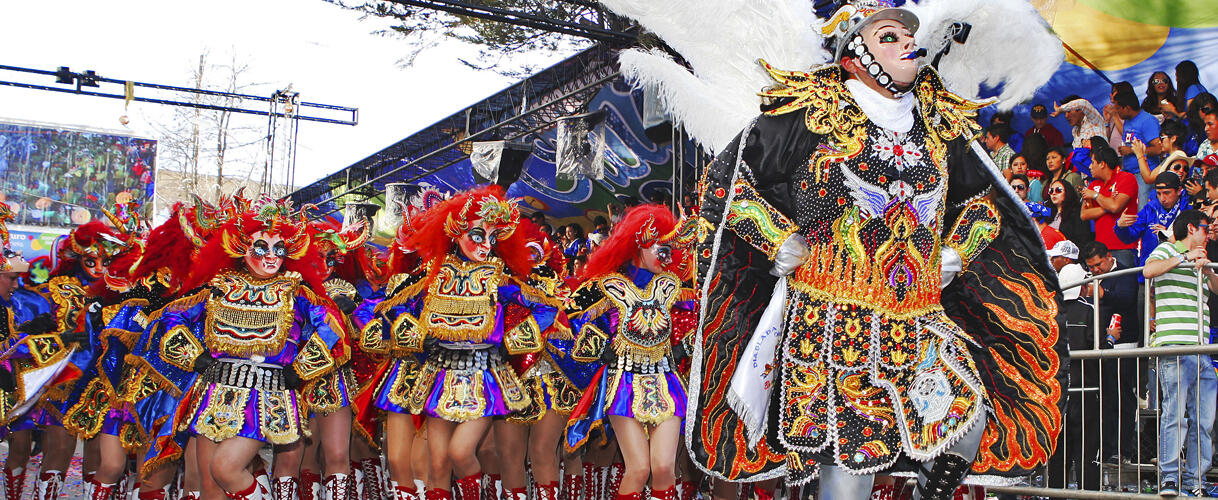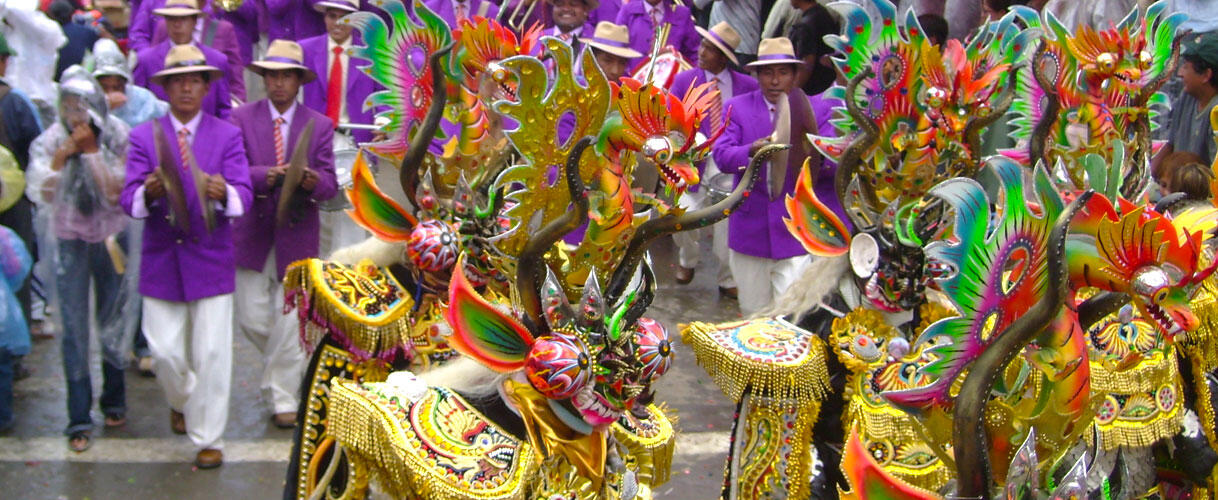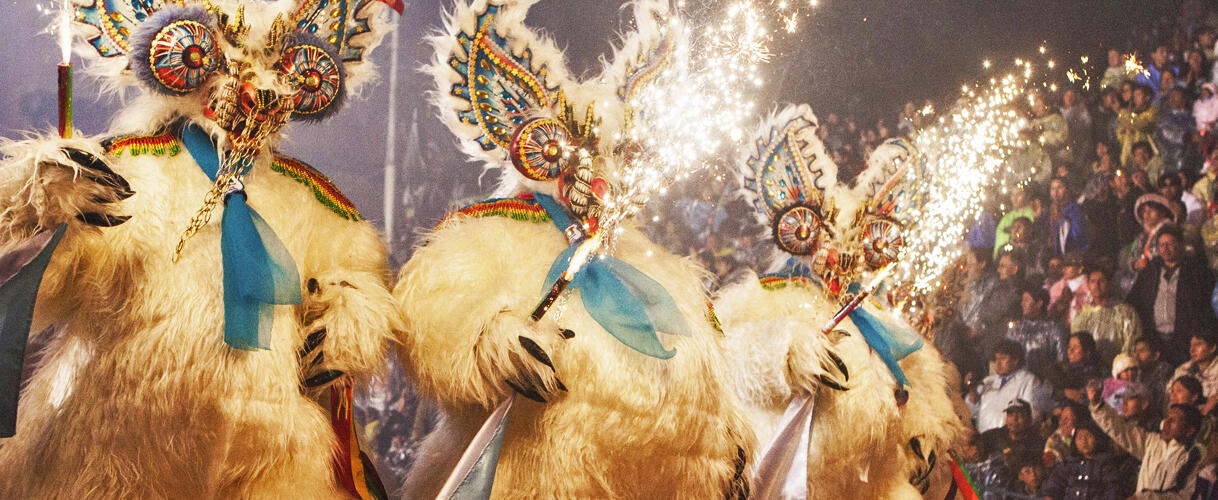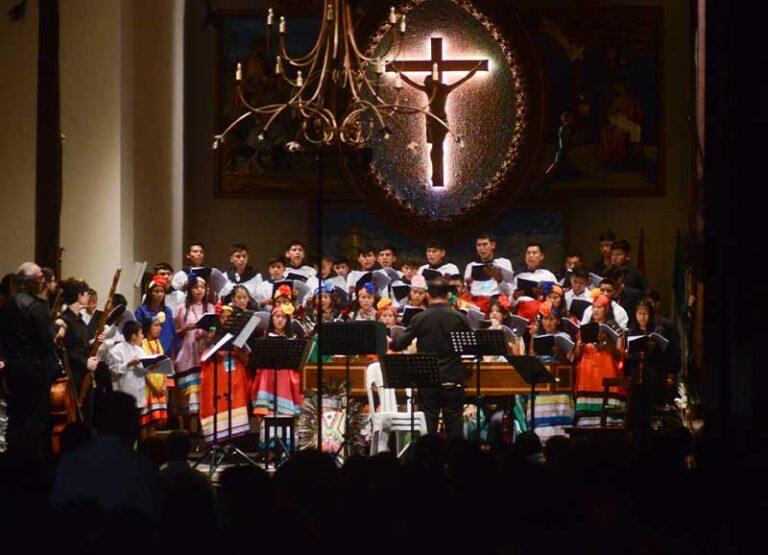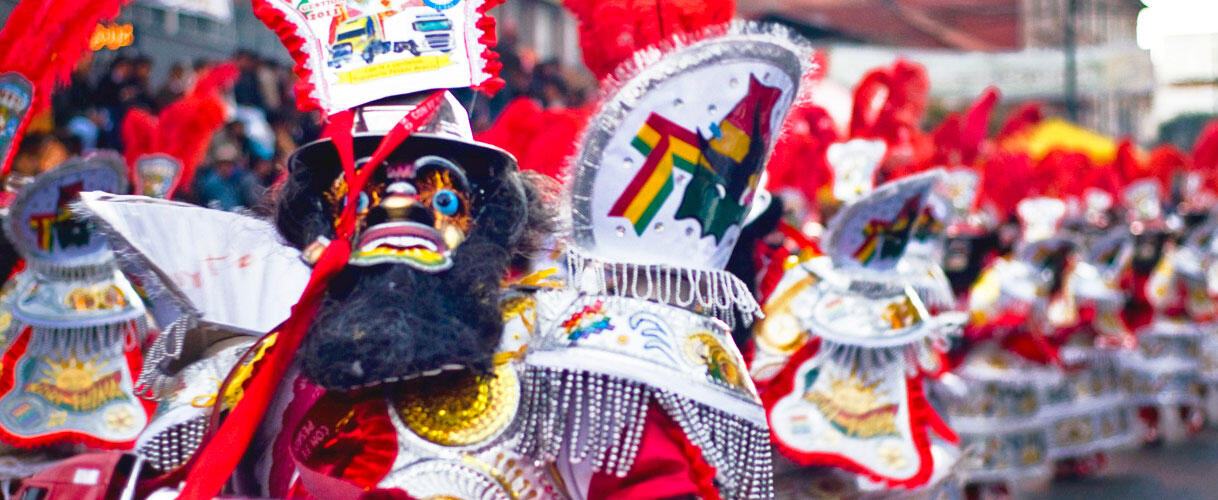Fiestas and culture festivals from 1 to 7 days
Carnaval de Oruro
Where: City of Oruro
Date: variable, february or march
Oruro city was founded during the colony as silver mining center in the region of the Urus. Today, it is one of the smallest cities of the country, but it retains its attractive aspect of European design of that period. The most important tourist activity is the Oruro Carnival, declared by UNESCO in 2001 as a ‘Masterpiece of the Oral and Intangible Heritage of Humanity’ due to its great religious and cultural value which is shown in the folk dance parade during two days.
One of the most important dances performed at Oruro Carnival is called Diablada (Dance of the Devils) that started in the ancient Andean cult in honor of the being living in the depths of the mines, which subsequently was adapted as ‘the devil’ from the colony.
International Festival of American Renaissance and Baroque music Misiones de Chiquitos (Missions of Chiquitos)
Where: Department of Santa Cruz - Chiquitania Region
Date: variable, march or april
Rated as the world's largest event of early music and one of the most influential. This meeting takes place twice a year since 1996, more than 370,000 people have seen 804 concerts master, carried forward by the talent of 285 groups and 4687 musicians from various countries around the world.
History
The Chiquitania region is located in the middle eastern of the Department of Santa Cruz (Bolivia), with approximately 220,000 km2, it constitutes 56% of the territory whole.
Six Bolivian Jesuit Missions which where declared Cultural Heritage of Humanity by UNESCO in 1990, are preserved in the Chiquitania. The only missions that have continued to keep missionary culture alive in South America since their founding.
In the second half of the 17th century, the missioners of the Society of Jesus (Jesuits) established the missions of Moxos (1682-1767) and Chiquitos (1691-1767) on the plain region of what is today Bolivia, where one of the most relevant cultural encounters during the Spanish America took place.
Music is one of the most important results in this process of syncretism, product of the missions or reductional practice. The Loyola missionaries used music as an bridge of evangelization (also taking advantage of the special skill and taste of the natives), producing an enormous wealth, in quality and quantity, without this the history of western music cannot be understood.
The restoration of the missions, which began in the 1970´s under the supervision of Swiss the architect Hans Roth, allowed for the recovery of more than 5,000 pieces from the Chiquitos musical archive, the most important collection of indigenous baroque music in South America.
Currently, the missionary temples are also venues for Renaissance baroque music festivals, with the Misiones de Chiquitos International Baroque Music Festival being the most important on the continent.
Folk parade of The Lord Jesus of The Great Power also known as the feast of “The Great Power” or “fiesta del gran poder”
Where: La Paz city
Date: variable, may or june
The feastivity of the Lord Jesus of the Great Power (Fiesta del Gran Poder) is one of the most important cultural manifestations and expressions of the cultural identity of La Paz.
According to popular belief it began with the arrival in the area of Ch'ijini of a painting with the face. The image was interpreted by “Aymara” tradition in which the face on the right was to receive positive petitions; the face on the left was to receive negative petitions and the face in the middle received personal petitions.
In 1930, the Catholic Church had the painting repainted, leaving only one face, and the one in the middle. Ever since then, this image is called “Jesus del Gran Poder” and a great celebration with the same name is held every year in its honor.
Originally the celebration was held in the popular zone of “Ch´ijini”, but nowadays, it has been extended to the city. During this festivity, dancers as well as spectators make a symbolic capture of other cultures areas.
La Morenada
Among the main dances of the celebration of “gran poder”, is “la morenada”. This dance originated with the aymaras and represents the suffering of the black slaves brought to the mita in “Potosi”.
The dance is one of the most elaborate of this Andean festivity where thue craftsmanship is expressed in the costumes´ embroidered masks,” mantas” and “polleras”.
In this dance we can appreciate a strong presence of the “aymara” woman dressed in a “pollera” (aymara skirt). The presence of the “Cholas” is very important; they present themselves with pride and elegance, along with the troop of “morenos” who advance slowly to the rhythm of the “matraca” (typical instrument) lead by the “Achachi Gala´87n”
Caporales
The “Caporales” is a dance inspired by the black foremen or “caporales” who used to control the slaves (fellow countrymen) on the colonial coca leaf estates. The dancers are dressed in bright and colorful costumes: embroidered pants and boots with little bells; they carry a whip, and a whistle. They perform acrobatic and elegant maneuvers to the beat of the music based on the agile rhythms of the Afro community. The women are beautifully dressed in short “polleras” and embroidered blouses.
Waca Tokhoris
The “Waca Tokhoris” is a dance that represents the arrival of bulls in America after the conquest, The dancers carry a representation of these animals, made of dry leather. The women are clothed with many superposed “polleras” (sometimes up to 25 ”polleras”) and a Ch´ucañ´96a” (cloak that covers their head).
The “Kusillo”, a noisy and sarcastic character, is always present in the dance of “wacas” He follows the dancers with acrobatic leaps. The “kusillos” costume is an adaptation of the European harlequin. It is characteristic, because of its similarity to a monkey, it has a long jacket that goes down to the knees with a combination of gray, and white or black pants, and a mask writh horns, that covers the entire head.
Another figure in this dance is the “Matador” that represents the Spanish bullfighters. As well there are milk maids and kaisillos.
Kullawada
The “Kullawada” is a dance which represents the textile activity of ethnic “aymara” groups from the Bolivian “Altiplano”. The dancers, men well as women. Carry a piece of Wood as a symbol.
The dance is lead by the whapuri or leader who has a larger piece of Wood, which which he directs the movements of the dancers; he is the only character in this dance who uses a mask with a very long nose and two faces, Usually young single people participate in this dance, which is to symbolize elegance and courtship.
Llamerada
The “Llamerada” is related with the most important economic activity of our agriculture, the breeding of llamas, it also recalls the domestication of the first chamelid in the Andean region; “guanacos”,” alpaca”, and “vicuñ96as”. The “Llameradas” wear on their heads a representation of ancient morenadas with four points, used by many different ethnic groups before the colony.
The dancers are dressed with traditional llama herder hats, small “ponchos”, and a plaster mask and in their hand they carry a q´urawa or sling. They also wear pants and Andean socks with sandals.
The female dancers wear elegantly embroidered blouses and carry an “Aguayo”. They are dressed in “polleras” and “abarcas” (sandals) and carry bags writh silver coins. The list of dances at the festivity of the Lord Jesus of the Great Power include; the Diablada “(mythological dance of ”supay”)”the incas”,”awatiris”, “suri sicuri”,”Tobas”, such as “Kantus”,” Quena Quenas” and “Sicuris”.
Request a quote
Festivities
Fiestas and culture festivals from 1 to 7 days



 HERE YOU WILL FIND OUT MORE ABOUT OUR BOLIVIA´S FESTIVAL PACKAGES:
HERE YOU WILL FIND OUT MORE ABOUT OUR BOLIVIA´S FESTIVAL PACKAGES:

